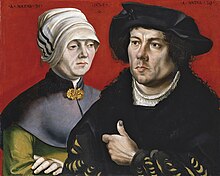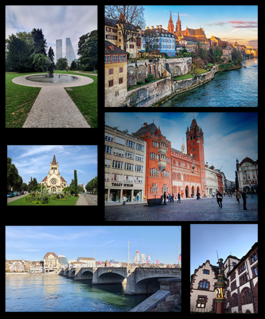
Basel, also known as Basle ( BAHL; German: Basel[ˈbaːzl̩], is a city in northwestern Switzerland on the river Rhine. Basel is Switzerland's third-most-populous city with about 175,000 inhabitants. The official language of Basel is German, but the main spoken language is the local Basel German dialect.
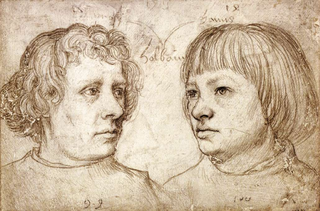
Ambrosius Holbein was a German and later a Swiss artist in painting, drawing, and printmaking. He was the elder brother, by about three years, of Hans Holbein the Younger, but he appears to have died in his mid-twenties, leaving behind only a small body of work.

Hans Holbein the Younger was a German-Swiss painter and printmaker who worked in a Northern Renaissance style, and is considered one of the greatest portraitists of the 16th century. He also produced religious art, satire, and Reformation propaganda, and he made a significant contribution to the history of book design. He is called "the Younger" to distinguish him from his father Hans Holbein the Elder, an accomplished painter of the Late Gothic school.

Paracelsus, born Theophrastus von Hohenheim, was a Swiss physician, alchemist, lay theologian, and philosopher of the German Renaissance.

Matthias Grünewald was a German Renaissance painter of religious works who ignored Renaissance classicism to continue the style of late medieval Central European art into the 16th century. His first name is also given as Mathis and his surname as Gothart or Neithardt.

Fussball Club Basel 1893, widely known as FC Basel, FCB, or just Basel, is a Swiss football club based in Basel, in the Canton of Basel-Stadt. Formed in 1893, the club has been Swiss national champions 20 times, Swiss Cup winners 13 times, and Swiss League Cup winners once.

David Joris was an important Anabaptist leader in the Netherlands before 1540.

Girolamo Francesco Maria Mazzola, also known as Francesco Mazzola or, more commonly, as Parmigianino, was an Italian Mannerist painter and printmaker active in Florence, Rome, Bologna, and his native city of Parma. His work is characterized by a "refined sensuality" and often elongation of forms and includes Vision of Saint Jerome (1527) and the iconic if somewhat anomalous Madonna with the Long Neck (1534), and he remains the best known artist of the first generation whose whole careers fall into the Mannerist period.

Jan Mostaert was a Dutch Renaissance painter who is known mainly for his religious subjects and portraits. One of his most famous creations was the Landscape with an Episode from the Conquest of America.
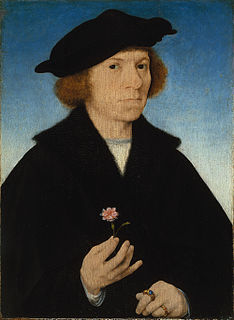
Joos van Cleve was a leading painter active in Antwerp from his arrival there around 1511 until his death in 1540 or 1541. Within Dutch and Flemish Renaissance painting, he combines the traditional techniques of Early Netherlandish painting with influences of more contemporary Renaissance painting styles.

Lucas van Valckenborch or Lucas van Valckenborch the Elder was a Flemish painter, mainly known for his landscapes. He also made contributions to portrait painting, and allegorical and market scenes. Court painter to Archduke Matthias, the governor of the Spanish Netherlands in Brussels, he later migrated to Austria and then Germany where he joined members of his extended family of artists who had moved there for religious reasons.

Jan van de Venne or Jan van der Venne, also known as Pseudo van de Venne, was a Flemish painter of genre, religious scenes, and cabinets who was court painter to the governors of the Southern Netherlands. Many of his works depict "low-life" genre scenes of tooth-pullers, card-players and hurdy-gurdy players, tronies and expressive religious scenes.
Fussball Club Basel 1893 has a long and illustrious history, that spans the period from 1893 to the present day. Having competed at the highest level of football in Switzerland for most of this time, FCB currently play in the Swiss Super League. The club was founded on 15 November 1893. At first the club played their home games in the Landhof stadium. During the mid- 1960s Basel they played their games in St. Jakob Stadium which was demolished in 1998. During the construction of the new stadium, between 1998 and 2001, the Stadion Schützenmatte was the clubs temporary home ground. Since 2001 Basel play home games at St. Jakob-Park, which is currently the largest club stadium in Switzerland.
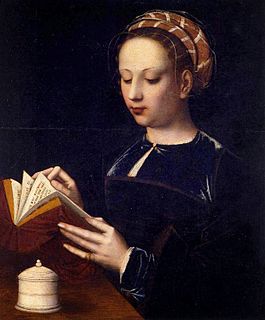
Ambrosius Benson was an Italian painter who became a part of the Northern Renaissance.

Cornelis van Cleve, Cornelis van Cleef or Cornelis van der Beke, nickname Sotte Cleve was a Flemish Renaissance painter active in Antwerp who is known for his religious compositions and portraits. Starting his career in Antwerp in the workshop of his father Joos van Cleve, he later worked for a while in London. When he failed to achieve success in England, he became insane and stopped painting.
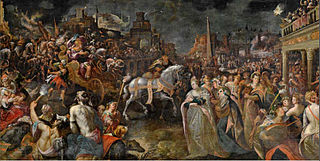
Gillis van Valckenborch or Egidius van Valckenborch was a Flemish painter and draughtsman who spent most of his career in Germany. He was a member of the van Valckenborch dynasty of painters who painted mainly landscapes. Unlike his family members, he is mainly known for his large-scale compositions with many swirling figures depicting scenes from ancient history or mythology. While his landscape drawings evidence his interest in landscape art no landscape paintings have been attributed to him.
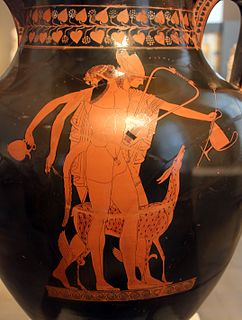
In art history, a Notname is an invented name given to an artist whose identity has been lost. The practice arose from the need to give such artists and their typically untitled, or generically titled works, an acceptable if unsatisfactory grouping, avoiding confusion when cataloging. The phrases provisional name, name of convenience and emergency names are sometimes used to describe anonymous masters; nonce name was at one time used.
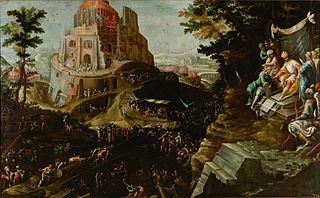
Frederik van Valckenborch was a Flemish painter and draughtsman known for his imaginary landscapes with figures executed in a late Mannerist style. His drawings are more realistic and demonstrate an impulse towards topographical accuracy. He was active mainly in Germany.

Jan Rombouts the Elder, Jan Rombouts (I), was a Flemish Renaissance painter, glass painter, draftsman, printmaker and glass designer. The subjects of his work are stories from the Old and New Testament and the lives of Christian saints. He was active in Leuven where he introduced the Renaissance innovations of Bernard van Orley and the Antwerp school.
FC Basel was started by an advertisement placed by Roland Geldner in the 12 November 1893 edition of the Basler national newspaper, requesting that a football team be formed and that anyone who wished to join should meet up the following Wednesday at 8:15 in the restaurant Schuhmachern-Zunft. Eleven men attended the meeting, generally from the academic community, founding Fussball Club Basel on 15 November 1893. All of them had spent some time in England and during that time found their way into football.
